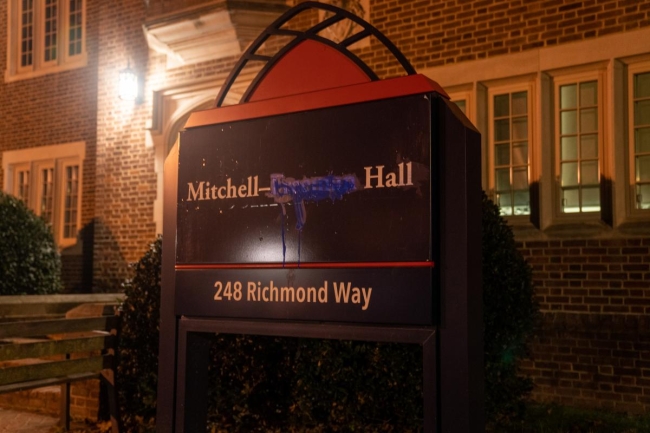You have /5 articles left.
Sign up for a free account or log in.

Douglas Southall-Freeman’s name was so contentious on the campus of the University of Richmond that someone spray painted over his name on the sign for Mitchell-Freeman Hall.
Ben Wasserstein
When the University of Richmond announced this week that it would remove the names of slaveholders, eugenicists and other known racists and supporters of white supremacy from six campus buildings, some Black current and former students were caught off guard.
One alumnus called it “a nice surprise.” A student leader on campus said, “It was a shock, to be quite honest.”
Their reactions reflected the low expectations many in and around the private university in Virginia had about the efforts and potential results of a commission formed a year ago to examine how and for whom campus buildings should be named. Just a year ago, university leaders had declined to rename two buildings named for the Reverend Robert Ryland and Douglas Southall-Freeman, despite repeated calls by some students and faculty to do so.
The commission was created as a response to the controversy over that decision, and the body had promised to “[undertake] a thorough review of naming issues, seeking to engage every member of the University community in the process.” It released a list of “naming principles” last Friday, and the university’s Board of Trustees and president, Kevin Hallock, announced the news of the name removals Monday.
“Ultimately, the call not just for two buildings to be renamed, but four additional ones, says a lot for the efforts to bring a more open culture to this university,” said Christopher Wiggins, a 2003 graduate who had been engaged with university officials in the name-change discussion for the past year.
However, Wiggins added, “It’ll take a lot more to regain the trust of the Black community.”
The decision to pull the names off the buildings caps a three-year battle with university administrators, led by Black students and alumni and non-Black allies and supporters, over honoring prominent people in the university’s history whose legacies are rooted in enslavement, segregation and racial violence.
“We recognize that not all members of our community will agree with these decisions. And we recognize that the University would not exist today without the efforts of some whose names we have removed,” Hallock said in a message sent Monday to students, alumni and others affiliated with the university and co-signed by the Board of Trustees. “In the end the Board concluded that the decisions outlined above are the best course of action for the University.
“Across our community, we heard clearly that a continued commitment to advancing diversity, equity, including and belonging must be a core element of our University and its culture. We share that commitment and believe these decisions are consistent with that objective,” Hallock’s message said.
A university spokesperson who was asked for additional comment by administrators referred to the campuswide message.
The university’s announcement came with a list of “naming principles” produced and recommended by the commission and accepted in principle by the Board of Trustees. Another commission is to be formed by this fall to decide exactly how to consider honoring people by naming buildings or structures after them. For now, the buildings whose names were removed will have no namesakes.
The battle over building names came to a head a year ago, when then university president Ronald Crutcher scrapped a much-maligned plan to add the name of a local newspaper publisher and civil rights activist, John Mitchell, to a dorm named for Southall-Freeman, a eugenicist and segregationist. Students were also fighting to remove the name of Ryland, a university founder and a slaveholder. The requests for the name changes were first made in a 2019 joint resolution by student government leaders.
Buildings and statues that honor people with racist pasts were already polarizing issues on many college campuses, especially those in the South. But after the police killing of George Floyd in 2020 and the national racial justice protests that followed, buildings and monuments of problematic historical figures became lighting rods for campus culture wars and sources of conflict across the country.
Many college campuses have since or are still undergoing soul-searching similar to the University of Richmond’s.
A recent controversy occurred at William Peace University, a private institution in Raleigh, N.C. The university commissioned a study in 2020, in the wake of Floyd’s murder, and a summary of the study report revealed that the college’s namesake owned slaves, that the Main Building on campus had been built by enslaved people, and that the school yearbook was dedicated one year to a protagonist in the 1898 Wilmington massacre.
The University of Alabama prompted a public outcry last month after administrators announced that the name of Autherine Lucy, the first Black student to enroll at the university, would be added to a building named for Bibb Graves, a former governor and a leader of the Ku Klux Klan. The state institution reversed its decision eight days after the backlash.
The commission created at the University of Richmond after its naming gaffe last year sought to build consensus on campus and contacted, surveyed and held listening sessions to provide opportunities for more than 7,500 students, alumni, parents, faculty and others to weigh in. The result was the stunning choice to remove the names from four more buildings than originally planned, all of which also had troubled namesakes.
And university leaders wasted no time making the changes.
“They said it would take effect immediately, but we figured it would be a few days,” said Christian Herald, a first-year student and president of the university’s Black Student Alliance. “But within an hour or two [on Monday], they were gone, taped over, plaques taken down.”
Herald was not a student at the university when the student government organizations passed the resolution to call for the building name changes, nor when the controversy over the renaming erupted last March. But she said she witnessed much of the student backlash, including a “disaffiliation” plan aimed at withdrawing engagement and involvement in campus activities and withholding financial support of the school, when she visited the campus, and she “was able to see evidence of the protests.”
“They would schedule campus tours and then find out that the tour guides had quit in protest,” she recalled.
Campus activists also urged community members not to refer to the building named for Southall-Freeman by name.
Herald said student protesters told supporters, “Don’t give that name power.”
Even seeing officials move quickly to remove the old names on Monday did not erase the memory of the long struggle to get the names of the original two buildings changed, said Shira Greer, president of the Black Student Coalition, which worked with the Black Student Alliance over the past year to press for the name changes and other demands by Black students, faculty, alumni and supporters.
“It was a low bar, and they definitely cleared it,” Greer said of the university’s naming decision. Like the rest of the campus community, she learned of the naming principles last Friday, then the announcement of the name removals on Monday.
“To come up with the principles first seemed kind of backwards,” she said. “I think they did their work relatively well … I think it really boiled down to having people who were willing to listen, who were really active and who made sure things were transparent.”
Confidence in the commission’s sincerity grew, Greer said, when a student representative—Jordyn Lofton, also a member of the Black Student Coalition—was added as a member. Lofton and Greer are among more than 600 people, encompassing various races and nationalities and including students, alumni and faculty, who signed the demands letter in March 2021, a document titled “Protect Our Web: A Statement on Black Student Welfare.”
Part of the conflict that led to the creation of the commission and the halt on the previous renaming plan stemmed from contentious interactions with Richmond Board of Trustees member Paul Queally, the university rector, who once referred to the school’s “Black, brown and regular students.”
The tone of Queally’s discussions on the matter, Greer said, was “pretty hostile” and “really disrespectful.”
Taking the names off the two buildings, Greer said, was “only the floor of what we want to see at this university.”








